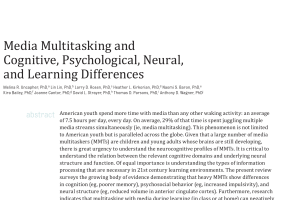Abstract
American youth spend more time with media than any other waking activity: an average of 7.5 hours per day, every day. On average, 29% of that time is spent juggling multiple media streams simultaneously (ie, media multitasking). This phenomenon is not limited to American youth but is paralleled across the globe. Given that a large number of media multitaskers (MMTs) are children and young adults whose brains are still developing, there is great urgency to understand the neurocognitive profiles of MMTs. It is critical to understand the relation between the relevant cognitive domains and underlying neural structure and function. Of equal importance is understanding the types of information processing that are necessary in 21st century learning environments. The present review surveys the growing body of evidence demonstrating that heavy MMTs show differences in cognition (eg, poorer memory), psychosocial behavior (eg, increased impulsivity), and neural structure (eg, reduced volume in anterior cingulate cortex). Furthermore, research indicates that multitasking with media during learning (in class or at home) can negatively affect academic outcomes. Until the direction of causality is understood (whether media multitasking causes such behavioral and neural differences or whether individuals with such differences tend to multitask with media more often), the data suggest that engagement with concurrent media streams should be thoughtfully considered. Findings from such research promise to inform policy and practice on an increasingly urgent societal issue while significantly advancing our understanding of the intersections between cognitive, psychosocial, neural, and academic factors.
This article was published in a special 2017 supplement of Pediatrics, a journal of the American Academy of Pediatrics. The supplement, “Children, Adolescents and Screens: What We Know and What We Need To Learn,” was produced by Children and Screens and includes the contributions of more than 130 interdisciplinary authors across 22 papers. See a complete list of articles included in the supplement.
